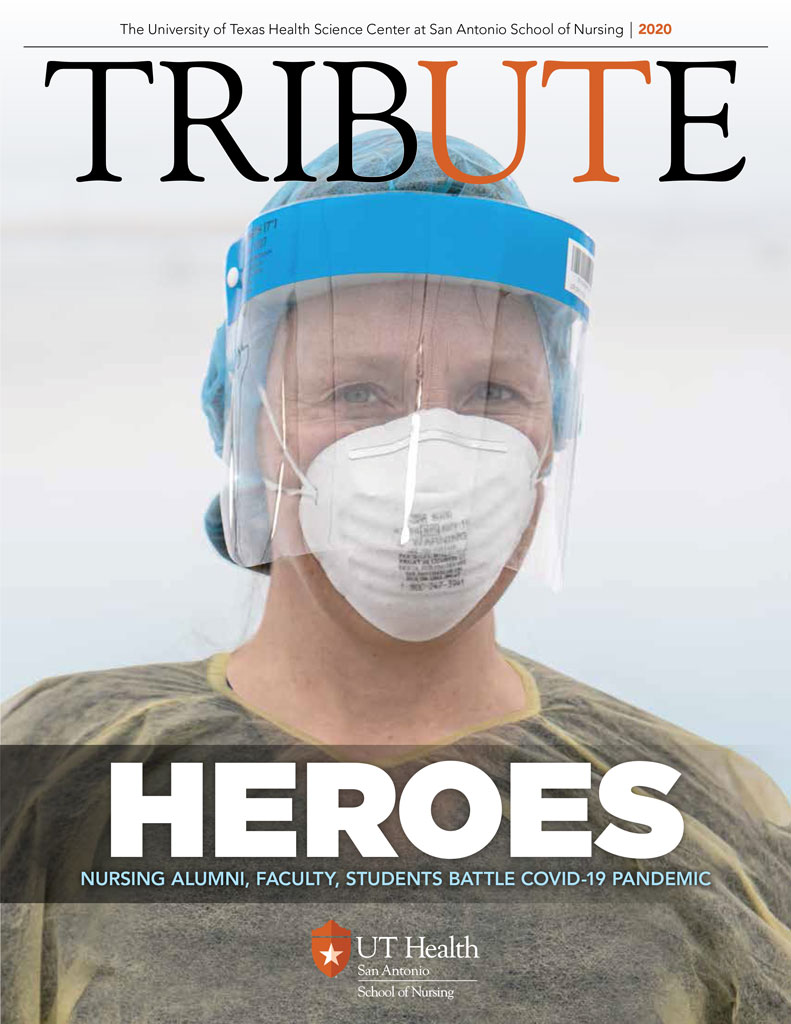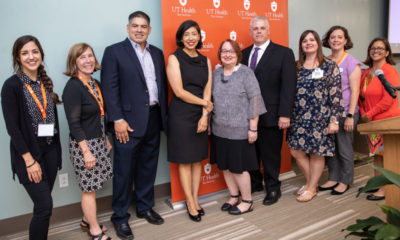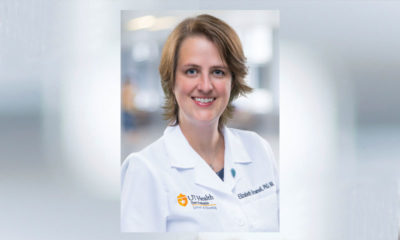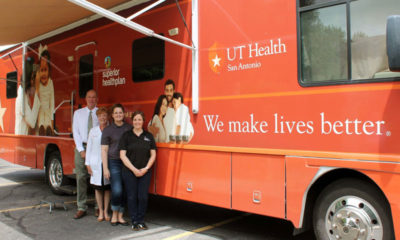School of Nursing Responds to COVID-19 Pandemic

By Catherine Duncan
When a global pandemic changed the world and threatened everyone’s health, UT Health San Antonio’s School of Nursing reacted swiftly and deliberately to the emergent health care needs of its university, city and county.
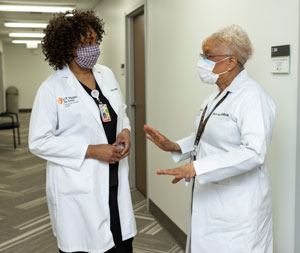
Eileen T. Breslin, Ph.D., RN, FAAN, dean and the Dr. Patty L. Hawken Nursing Endowed Professor, explains that part of the fabric of the nursing school is to be responsive to the needs of the community.
“When we are called on for assistance—whether it is from our own university or from city or regional leaders—nursing faculty, staff and students step up and volunteer. Our faculty are innovative and creative. They know how to set up systems to provide health care services. Nurses are people of action.
“And, I believe that UT Health has responded in an extraordinary way with the entire community in mind. The nursing school’s assistance in the COVID-19 response has been inspirational and vital to the success of flattening the curve.”
Cindy Sickora, D.N.P., RN, vice dean of practice and engagement, said the school’s COVID-19 response began with participation in the Critical Mission Team, created by William L. Henrich, M.D., MACP, UT Health president. “On March 5, the university identified 19 employees who were out of the country on business trips. UT Health had to create protocols regarding traveling within the country and returning to the U.S.”
Dr. Sickora worked closely with Michael Charlton, Ph.D., assistant vice president for risk management in UT Health’s Department of Health and Safety. The School of Nursing started getting phone calls regarding COVID-19 and traveling from employees.
UT HEALTH HOTLINE
“We had to be able to help those who were already abroad plus answer questions about spring break and traveling. The number of phone calls kept increasing. I couldn’t handle the volume anymore. On March 12, we decided to create the UT Health Hotline; the hotline started on March 18 with an average of 50 calls per day,” she said.
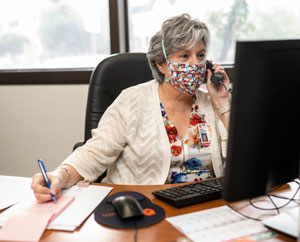
For the UT Health Hotline, Cheryl Farner, M.S.N., APRN, FNP-BC, and Karen O’Rourke, M.S.N., RN, began training on March 16 and were working the hotline on March 18, Dr. Sickora explained. “Initially, they were helping employees who were returning to the U.S. and had to be quarantined. Then spring break occurred, and they helped those who traveled through hotspots with their quarantines,” she said. “Next we started seeing people testing positive in the community, and health care workers were being exposed to those who were COVID-positive. As time went on, the nursing school helped develop the protocols and respond to the changing needs of the callers.”
The UT Health Hotline also assists faculty, staff and students who are concerned about needing to be tested for COVID-19. This development led to the School of Nursing responding quickly and creating an on-campus COVID-19 testing site.
ON-CAMPUS TESTING
Kenneth P. Miller, Ph.D., RN, CFNP, FAAN, FAANP, who holds the School of Nursing Professorship in Aging, said once the UT Health Hotline was established, the school started getting requests for COVID testing. Working with the UT Health San Antonio Police Department, nursing officials decided to use space in a parking lot near the school.
The School of Nursing was able to set up the COVID-19 testing site because of funding from the Hyundai Hope On Wheels® and San Antonio-area Hyundai dealers, which awarded UT Health San Antonio a $100,000 grant for drive-through COVID-19 testing.
With the Mobile Health Unit and an adjacent tent, Dr. Miller and Heidi Miller, M.S.N., APRN, FNP-BC, began administering the nasal and oropharyngeal swab test to UT Health personnel who received an order from a physician through a telehealth visit or who called the UT Health Hotline and a telehealth visit was scheduled with a nurse practitioner at the school’s Wellness 360.
Those with orders are given an appointment time to drive up for the test while remaining in their vehicles. “Heidi and I can now complete a test in four to five minutes. I warn people being tested that it is not a comfortable test. The swab goes in the nose and through the back of the throat to the oropharynx. I tell them if they don’t tear up, I didn’t do it right. Everyone who has come here to be tested has been very thankful and appreciative—despite the discomfort of the test,” he said.
Since March 25, the Millers, who are not related, have been performing tests at 8 a.m. and 2 p.m. weekdays. In mid-May, when testing expanded to UT Health patients, testing was added Sunday mornings. Testing is now being done for pre-surgical radiology, ENT, dermatology and oncology patients with UT Health Physicians and the Mays Cancer Center. “We do these tests at 8 a.m. so doctors have results before the procedure scheduled the next day.”
Dr. Miller said the nursing school has been working with the School of Dentistry to help it set up a testing site for pre-surgical patients at its Center for Oral Health Care and Research. “We learned a lot during this process about procedures and policies. We are now passing that information on to our dental colleagues,” he said. “We want to give the best service we can to our community. Patients deserve that.”
FREEMAN COLISEUM
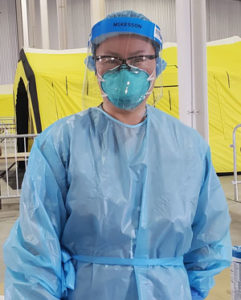
Heidi Miller, assistant professor/clinical, was one of many nursing faculty members who volunteered at the Freeman Coliseum, which became the city and county’s main screening and testing site. “We were able to go there and help with screening through their call center as well as administering the swab tests. Our faculty and graduate NP students have been helping wherever the need has arisen.
“While volunteering there, we were able to see how it was organized on a large scale so we could figure out how to create our testing site on a smaller scale,” she said. “We brought that knowledge back to campus so we could start testing UT Health students, faculty and employees.”
REGIONAL ASSISTANCE
The School of Nursing also received a call for assistance from the Southwest Texas Regional Advisory Council (STRAC), which is designated by the Texas Department of State Health Services to develop, implement and maintain the regional trauma and emergency health care system for Bexar and 21 surrounding counties.
Dr. Breslin said the nursing school helped at STRAC’s call center. “Faculty volunteered on weekdays and weekends. They took calls, assessed symptoms, scheduled testing appointments, and followed up after tests,” she said. “From my perspective, I have seen our faculty be leaders in action without hesitation.”
ON-CAMPUS SCREENING
When Andrea Marks, M.B.A., CPA, UT Health chief operating officer, asked the School of Nursing to create a screening process for students, faculty and staff coming onto campus, 16 faculty volunteers signed up that same day. In collaboration with Police Chief Michael J. Parks, Dr. Sickora, with the leadership of Lark Ford, Ph.D., M.A., M.S.N., RN, started with 15 screening sites across the campus.
Dr. Breslin said, “We engaged students from not only our school but also the Long School of Medicine, School of Dentistry and the School of Health Professions. In less than 24 hours, the on-campus screening was up and running. In addition, Dr. Ford created a training video for everyone who volunteers for on-campus screening.”
Dr. Ford, associate professor/clinical, said those who volunteer wear masks and gloves. First, a person’s temperature is taken with a no-touch thermometer. Then a series of questions regarding COVID-19 symptoms are asked. “We also make sure everyone coming on to campus is wearing a mask,” she said. “Each person who passes the screening has a sticker put on their badge that is good for that day.”
If someone tries to come on campus who has a fever or answers yes to any of the symptom questions, then he or she is given directions on how to seek medical attention, Dr. Ford explained.
As with all the other responses to the pandemic, screening is adapting as time passes. “At first, we had 15 stations, but now we have six. We activate and deactivate stations depending on the need. As more employees return to work on campus, adjustments will be made,” she said.
While students primarily were the initial volunteers at the stations, the ending of the spring semester meant many are now gone for the summer break, Dr. Ford said. “Now UT Health employees are staffing the screening stations. The employees have really stepped up. I am amazed by everyone who is volunteering to keep this campus safe.”
Dr. Sickora, who has experience in disaster relief after hurricanes, said she is proud that the School of Nursing has been at the center of the COVID-19 pandemic response. “Nurses are the type of people who respond when a disaster occurs. That is just who they are. And, in this health care crisis, we worked with the most interprofessional team I’ve ever seen. At UT Health, we all worked together to stop the spread of this deadly disease. Together, we made a difference.”

